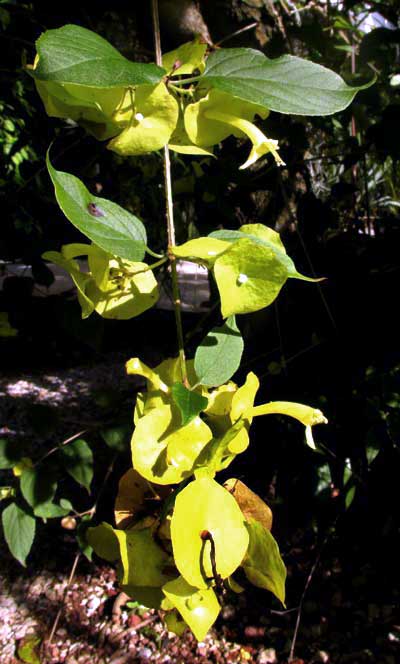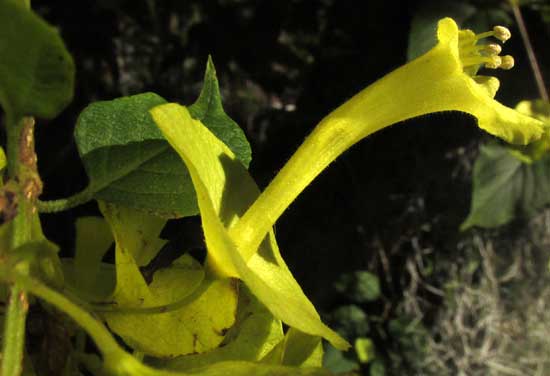Excerpts from Jim Conrad's
Naturalist Newsletter
from the November 5, 2017 Newsletter, with notes taken in mid October near Tepotzlán, Morelos state, MÉXICO
Elevation about 5315 ft (1620m), at 18°59′07″N 99°05′59″W
CHINESE HAT
During my mid-October visit with a plant-loving friend near Tepotzlán, Morelos, in the high elevations just south of Mexico City, one of the most unusual plants seen was the one shown below:

Below, a close-up side view of one of the flowers makes it easier to figure out what we're seeing:

The flaring, yellow, saucer-like part at the left is an expanded calyx with little indication of separate sepals. The yellow cylinder pointed at the image's top, right corner is the corolla, with stamens emerging from the flower's throat. Below, a closer look at the blossom's mouth shows more interesting details:

Features to notice here include that the corolla is bilaterally symmetrical -- only one way you can cut across it to produce mirrored images -- and the flower's four stamens cluster at the corolla tube's top. The outer two stamens are longer than the inner two. When four stamens occur in two pairs of different lengths, they're said to be "didynamous." These are good field marks, for bilaterally symmetrical corollas with didynamous stamens are often featured in two commonly encountered families, the Vervain and Mint Families.
My old Manual of Cultivated Plants by L.H. Bailey places our yellow-flowered, evergreen shrub acting like it wants to be a vine in the Vervain Family, but now I see that it's been switched to the Mint Family. Our plant is HOLMSKIOLDIA SANGUINEA, in English variously known as Chinese Hat, Mandarin Hat, and Cup-and-Saucer Plant. It's native to the Himalayan Mountains, but is cultivated in warm areas worldwide, and has escaped and "gone wild" in many countries.
The sanguinea part of its binomial means "blood red" while the genus name commemorates Johan Theodor Holmskiold, a Danish botanist back in the 1700s. The sanguinea part makes sense when we learn that the flower parts can display various arrangements of red, orange and yellow. Apparently the plant's namer had a red-flowered one.
The genus Holmskioldia contains only this one species.